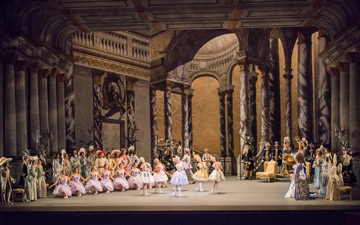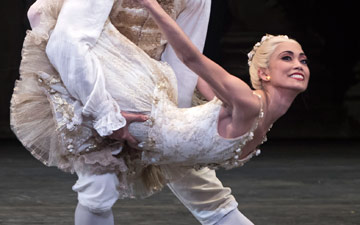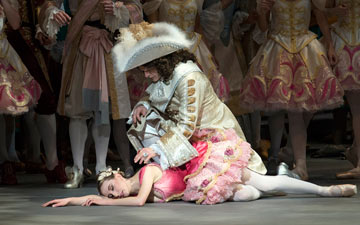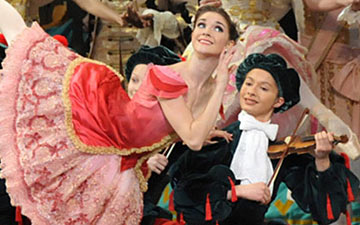
© John Grigaitis. (Click image for larger version)
American Ballet Theatre
The Sleeping Beauty
★★★★✰
New York, Metropolitan Opera House
1, 3 (matinee) July 2019
www.abt.org
www.metopera.org
Beauty Returns
In the final week of American Ballet Theatre’s spring season, the company has brought back its 2015 production of The Sleeping Beauty, last performed here in 2016. The production, by the company’s artist-in-residence Alexei Ratmansky, is often referred to as a “reconstruction,” in other words, a staging informed by historical sources, including notations, period photographs, drawings, personal account and early films etc. Much like a critical edition in music, it attempts to scrape back the layers of habit and performance tradition to rediscover something close to the original “text,” in this case, Marius Petipa’s steps. There is also something deeper, an effort to rediscover a different way of dancing, closer to that of the late nineteenth-century, less influenced by contemporary technique (high legs, big jumps, steely balances, etc.). In this project – as in his subsequent reconstructions – Ratmansky has placed his choreographic imagination at the service of Petipa, and yet, as one might expect, the results reflect his own interpretation, his taste, his esthetic choices.
The basic “text” is a set of notations in Stepanov Notation made by ballet masters at the Imperial Ballet at the end of Petipa’s tenure, roughly 1903-1906. But one of the interesting things about this reconstruction is that it is a work-in-progress. As more information has emerged, Ratmansky has introduced it into the fabric of the ballet, making changes, some subtle, some more radical. The current ABT performances include new choreography found in two sets of drawings by the dancer Pavel Gerdt, who performed the role of Prince Désiré in St. Petersburg in the 1890’s. One of these came to Ratmansky’s attention almost by chance. Last year, the Bakrushin Museum held an exhibit dedicated to Petipa with materials from its collection and the Bolshoi Library, curated by the Russian historian Sergei Konaev. Ratmansky saw a report about the exhibit on Russian television. Peering at the screen, he caught a glimpse of the drawings, and immediately reached out to the museum to request a copy*.
The images, from 1894, contain a frame-by-frame breakdown of the steps, some of which differ from those found in the later notations. Other changes – mainly questions of musical timing – come from the study of two piano scores kept at the Harvard Libraries, in the same archive where the Stepanov Notations are stored. It is fascinating to see how even in the span of ten years, between 1893 and 1903, the steps had changed – dance is a notoriously fluid art. In that fluidity lies some of its excitement – the steps live and breathe with each performance and cast.

© Doug Gifford. (Click image for larger version)
There has also been a natural evolution in ABT’s staging. In 2015 , Sleeping Beauty was Ratmansky’s second attempt at a reconstruction. He and Tatiana Ratmansky, his wife and choreographic assistant, were adamant about certain details: the legs should be kept as close to 90 degrees as possible, the feet in repose (known as B+ position) should be soft, or even slightly flexed. No splits, no acrobatics. Some of those rules have been softened. Legs in développé have crept higher, though they are still far from the ubiquitous 180 degrees of modern-day arabesque penchée. In the two performances I saw, on July 1 and 3 (matinee), the dancer playing Bluebird (Gabe Stone Shayer on July 1; Joo Won Ahn on July 3) executed very wide, contemporary-looking splits in the jumps. A few canonical details, like the développé in the lifts during the wedding pas de deux have been restored, despite the fact that they do not appear in any of the notations. (The consensus seems to be that they were added by Margot Fonteyn.) In the diagonal of rocking steps executed by Aurora during her solo in the final act, she now bends the back knee, as in most productions. Earlier, Ratmansky had insisted on a version with straight legs. Over time, his own taste has adapted.
But many stylistic details have remained: the soft, almost bent-kneed arabesques; the foot held in either coupé, or at mid-calf, or at knee level; the chainé turns on demi-pointe (except in the wedding pas de deux); the extreme épaulement and bending at the waist and detailed use of the head and shoulders. And, of course, the vivid and copious mime. These are the elements that give the production its look and feel: warm rather than regal, lilting rather than dramatic, melodious and graceful rather expansive and grand. The company has grown more used to this softer style, after repeated exposure; for the last two years the dancers have been performing Harlequinade, with which it has much in common. For the most part, the dancers look comfortable and fluent.
Some of the changes have a big effect, others are simply about texture. Originally, the “finger fairy” (Violente) stood still for 8 whole beats at the beginning of her solo, feet planted in first position, antennae vibrating. Now she runs on and begins almost right away. I thought the original was funnier, but it was certainly odd. A short passage for Carabosse-dressed-as-a-beggar-woman in the Rose scene (the “lament”) has been cut. No loss. Aurora’s solo after pricking her finger with the spindle is wilder, almost like a mad scene, reminiscent of Giselle. Her appearance in the Vision happens mid-stage rather than far upstage. She stands, illuminated by a shaft of light, like an apparition. (This works very well, I think.) In another wonderful addition to the Vision, Aurora rests on the prince’s back as he lowers into a lunge; a very similar move happens in Harlequinade. And yet another: as the prince pursues the vision of Aurora around and around a cluster of nymphs, three times, he finally decides to pass through the cluster in an attempt to capture her. A short-cut! She still gets away.

© John Grigaitis. (Click image for larger version)
More changes await in the wedding pas de deux: In a new pose derived from the Gerdt drawings, Aurora does an arabesque penchée behind the prince’s back as he holds her behind him. The famous fish dives, a later addition to Sleeping Beauty, are now gone, replaced by a very interesting pose that echoes one in the Rose Adagio. Supported by the prince, Aurora tilts to one side, extending her leg to the other side, while twisting her torso slightly so she can look up into his eyes as he gazes down into hers. In the Rose Adagio she does the same thing while one of the Cavaliers is supporting her, except she looks away. Before she wasn’t in love; now she is. Another pose is repeated from the vision scene, in which her torso leans backward, almost flat, while her leg stretches toward the front front. These restored details reveal internal echoes in the ballet. Another echoed image is the gesture for “sleeping,” two hands by the cheek, first proposed by the Lilac Fairy in the Prologue, and then repeated by Aurora in the Vision scene.
None of these changes alters the basic feel and look of the production. It proposes that Sleeping Beauty is not really the story of a love quest – as it’s often depicted – but rather a fable about order and disorder, harmony and disharmony, the balance between good and evil. Forgiveness is a running theme; Aurora’s father, King Florestan, forgives his master of ceremonies Catabulette after he makes the fatal mistake of forgetting to invite the evil fairy Carabosse to the christening. At his wife’s bidding, the king also forgives the knitters who smuggle spindles into the palace gardens, against his decree. And in the end, he forgives Carabosse, despite all her mischief, and invites her to his daughter’s wedding. In contrast, Prince Désiré’s court is cruel and vapid. The countesses and marquises treat his elderly tutor with contempt, hitting him with their riding crops. No wonder the prince is unhappy.
Both casts I saw pulled off the new choreography well. The two Auroras had contrasting strengths. On July 1, Isabella Boylston looked natural in the soft, almost Romantic poses, dancing with freedom and expansiveness. Her confidence seemed to grow after the successful completion of the Rose Adagio balances, which elicited loud cheers. Her light, sharp jump added a note of spontaneity and spirit. If anything, she could have used her face, and her eyes, more dramatically. In contrast, Cassandra Trenary’s acting was exceptionally vivid. She sought out the other dancers with her eyes, whether asking her father for permission to dance, or calling out to Prince Désiré during the Vision, or peering shyly at one of her suitors in the Rose Adagio. Trenary’s balances and jumps were less spectacular, but her phrasing had more of an arc, and she used her arms with a more precise sense of shape and coordination.

© John Grigaitis. (Click image for larger version)
Aran Bell, thrown in at the last minute on Monday to replace James Whiteside, showed no sign of strain. He has proven his mettle this season in ballet after ballet – a solid partner, an elegant presence, and a clean and precise dancer. The prince’s single variation, in the last act, is a gauntlet of beaten jumps, including a lengthy series of brisés volés, which comes after doing a series of double tours to coupé – no joke for a dancer of his height. He didn’t falter. Joseph Gorak, on July 3, was supremely elegant, with perfectly calibrated turns and gorgeous lines. But his jumps lacked lift and the beats could have been clearer. His partnering, on the other hand, is much improved.
Other highlights: Keith Robert’s terrifying, cackling, wide-mouthed, finger-jabbing Carabosse, not someone you’d like to meet in a dark alley. Ever. Stella Abrera’s beauteous and sophisticated Lilac Fairy, who always arrives just in time to fix any situation. Catherine Hurlin’s “finger” fairy, whose comic timing adds a layer of humor to this emphatic role. The entire cast of the garland dance, which, with its complex patterns and simple steps, is like a music box come to life. Courtney Lavine and Thomas Forster in the Cinderella divertissement, who, in just a few bars of music, managed to tell a whole story with extraordinary charm.

© Gene Schiavone. (Click image for larger version)
There are some less convincing details. Not enough attention is paid to the baby in the christening scene. The courtiers are too few, and rather stiff. Other issues have to do with the physical production, loosely inspired by the Bakst 1921 Ballets Russes designs for The Sleeping Princess. The knee-length dresses and tutus for the fairies and Aurora are flattering and lovely, but the colors are flat, and lack vividness. Some of the men’s costumes are quite ugly; and the hats, in general, are too large, almost cartoonishly so. That and the wigs aren’t well fitted. Richard Hudson lacks Bakst’s flair for color and shape. The staircase for Aurora’s big entrance in the birthday scene is too short – it makes her arrival less exciting than it should be. The giant eagle that hangs over Aurora’s bed in the awakening scene, with its beady red eye, is hideous.
Nevertheless, four years after its première, the production is holding up well. It feels alive, filled with ideas about what Sleeping Beauty represents, about style, about classicism and Petipa, and about ballet itself. It won’t please everyone, and no doubt some may find its lack of bravura and exaltation disappointing. But what it offers in exchange – poetry, balance, and steps that speak rather than declaim, is perhaps more interesting.
*Ratmansky told me this story in the course of conversations related to a book, about him, that I’m currently working on.

















So interesting, helpful – brava!
Thank you so much
Thanks for this terrific detailed review. It was very informative to read it after I’d seen the Friday July 5 performance. Also the review is thought provoking and gave me some new ways to see this reconstruction. I chose this performance frankly for the dancers and not the dance. I’ve seen many versions of SB but had never seen Ratmansky’s. I found it fascinating even if there were aspects I didn’t like. I absolutely loved both Lane and Cornejo. They are both wonderful artists and really made this evening one of the best ballet experiences I’ve had. It was thrilling to see how they inhabited their roles!
This is the best comment I could hope for! My main goal is to inform and provide background, so it seems that at least on this occasion I have succeeded. Cheers, M
Thank you for this review. I’ve seen all of ABT’s SB productions over the years and like this the best, as it feels the most authentic, knowing of Ratmansky’s efforts to bring it back to Petipa’s original productions. Second best would be the first ones I saw, basically the same as the Royal Ballet’s. I agree with your comments about the wigs (thank you!) — they are better than what the Bolshoi puts on female dancers’ heads, but still silly. Additionally, it is weird that Aurora, as danced by Hee Soo, a brunette in earlier acts, comes out in the final act with a blond wig! And the hoop pantaloons on the male Polish dancers in Act III — a bit much. Also agree with you about the fairy’s unremarkable costumes, given the importance of their characters in the ballet. I thought the orchestra on July 6 matinée did an excellent job, particularly the horns. I wish a dance scholar would write a book about the different SB productions throughout the ballet’s existence!